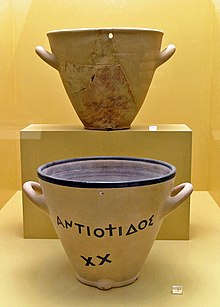
Back ساعة مائية Arabic كليبسيدرا ARZ Reló d'agua AST Su saatı Azerbaijani Воден часовник Bulgarian জলঘড়ি Bengali/Bangla Rellotge d'aigua Catalan Vodní hodiny Czech Vandur Danish Wasseruhr German

A water clock or clepsydra (from Ancient Greek κλεψύδρα (klepsúdra) 'pipette, water clock'; from κλέπτω (kléptō) 'to steal' and ὕδωρ (hydor) 'water'; lit. ' water thief') is a timepiece by which time is measured by the regulated flow of liquid into (inflow type) or out from (outflow type) a vessel, and where the amount of liquid can then be measured.
Water clocks are one of the oldest time-measuring instruments.[1] The simplest form of water clock, with a bowl-shaped outflow, existed in Babylon, Egypt, and Persia around the 16th century BC. Other regions of the world, including India and China, also provide early evidence of water clocks, but the earliest dates are less certain. Water clocks were used in ancient Greece and in ancient Rome, as described by technical writers such as Ctesibius (died 222 BC) and Vitruvius (died after 15 BC).
- ^ Turner 1984, p. 1